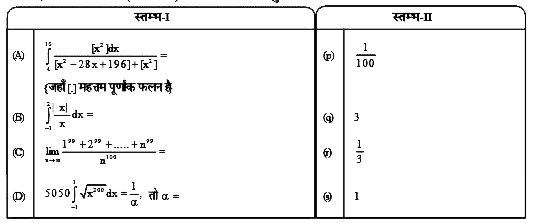यदि f ( 8 - t) = f (t) तथा ∫40f(α)dα=8 हो, तो ∫80f(γ)dγ का मान होगा -
4
8
16
32
The correct Answer is:C
Step by step video, text & image solution for यदि f ( 8 - t) = f (t) तथा int _(0) ^(4) f (alpha ) d alpha = 8 हो, तो int _(0) ^(8) f ( gamma) d gamma का मान होगा - by Maths experts to help you in doubts & scoring excellent marks in Class 12 exams.
Topper's Solved these Questions
- BOOK - ALLEN HINDICHAPTER - DEFINITE INTEGRATIONEXERCISE - Exercise - 03 (सत्य / असत्य)6videos
DEFINITE INTEGRATION
- BOOK - ALLEN HINDICHAPTER - DEFINITE INTEGRATIONEXERCISE - Exercise - 03 (स्तम्भ सुमेलन)3videos
DEFINITE INTEGRATION
- BOOK - ALLEN HINDICHAPTER - DEFINITE INTEGRATIONEXERCISE - Exercise - 01 (सही विकल्पों के चुनिए एक या एक से अधिक सही उत्तर है)9videos
DEFINITE INTEGRATION
- BOOK - ALLEN HINDICHAPTER - CONTINUITY EXERCISE - EXERCISE -05 [B] (JEE-ADVANCED: PREVIOUS YEAR QUESTIONS)2videos
CONTINUITY
- BOOK - ALLEN HINDICHAPTER - DETERMINANTEXERCISE - DO YOURSELF -91videos
DETERMINANT
Similar Questions
समाकल ∫0−∞x.exdx का मान परिमित नहीं होता
04:48View Solutionनिम्न प्रश्न में दो स्तम्भ में वत्क्व्य (statements) दिये गए है जिनका सम्मेलन (match) करना है । स्तम्भ - I(Column-I) के वत्क्व्यो को A, B, C तथा D नामित किया गया है जबकि स्तम्भ -II - (Column-II) के वत्क्व्यो को p,q, r तथा s नामित किया ज्ञात है। स्तम्भ- I (Column-I ) में दिए गए कोई एक वत्क्व्य स्तम्भ -II (Column-II ) के एक वत्क्व्य से सही सुमेल करता है।
 08:37View Solution
08:37View Solution∞∫0x(1+x)(1+x2)dx
01:04View Solutionफलन f(x)=⎧⎨⎩e1/x−1e1/x+1जबx≠01जबx=0 का x=0 पर सततता का परीक्षण कीजिए।
02:23View Solutionसमीकरण निकाय λx+y+z=0,−x+λy+z=0,−x−y+λz=0 का एक अशून्य हल होगा यदि λ का वास्तविक मान है
05:50View SolutionIf f(x)=a+bx+cx2andα,β,γ are the roots of the equation x3=1,then|abcbcacab| is equal to a.f(α)+f(β)+f(γ) bf(α)f(β)+f(β)f(γ)+f(γ)f(α) c. f(α)f(β)f(γ) d. −f(α)f(β)f(γ)
00:50View SolutionIf the function f:[0,8]→R is differentiable, then for 0<α<1<β<2,∫80f(t)dt is equal to (a) 3[α3f(α2)+β2f(β2)] (b) 3[α3f(α)+β2f(β)] (c) 3[α3f(α2)+β2f(β3)] (d) 3[α2f(α3)+β2f(β3)]
01:40View Solutionif x=phi(t) and int f(x)dx=F(x) then int f(phi(t))phi'(t)dt=(A)phi(x)(B)F(t)(C)F(x)(D)F'(x)
View SolutionLet f be a twice differentiable function on [0,2] such that f(0)=0,f(1)=2,f(2)=4, then prove that f′(α)=2 for some α ∈(0,1) f′(β)=2 for some β ∈(1,2) f''(γ)=0 for some γ ∈(0,2)
View Solutionf(x)=x^(4)+ax^(3)+bx^(2)+cx+d. If alpha
04:19View SolutionIf f(x)=∫x0tsintdt, then f'(x) is
04:02View SolutionIf it is known that ∫100f(x)dx=17and∫80f(x)dx=12, find∫108f(x)dx , given f(x) is continuous.
04:32View SolutionSuppose α,β,γ are roots of x3+x2+2x+3=0. If f(x) = 0 is a cubic polynomial equation whose roots are α+β,β+γ,γ+α then f(x) =
02:50View SolutionSuppose α,β,γ are roots x3+x2+2x+3=0. If f(x)=0 is a cubic polynomial equation whose roots are α+β,β+γ,γ+α then f(x)=
03:55View Solutionयदि f(x)=8−xPx−4 , तो फलन का परिसर क्या होगा?
02:00View Solution

